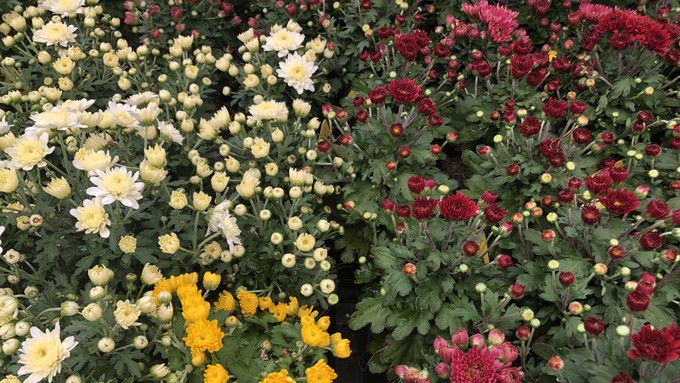
Autumn starts on cool side – with a chance of rain coming soon

One sign of early fall surely is all the chrysanthemums on sale and ready to transplant. These are great for fresh garden color, and indoor color, too. Kathy Morrison
Happy first day of fall! Sacramento starts a new season with beautiful autumn weather and just a touch of chill in the morning air.
Temperatures for this first week of fall will be on the cool side – as much as 10 degrees below normal. According to the National Weather Service, Sacramento can expect afternoon highs in the upper 70s and low 80s through next weekend. Sacramento’s average high for late September: 88 degrees.
Meanwhile, our overnight lows will remain just about average – 56 degrees. That means soil will retain its summer warmth for at least a little longer; that’s good for new transplants.
Due to a large storm front, rain is expected for much of Northern California on Monday, but most of those clouds will pass Sacramento by. The weather service estimates Sacramento’s chance of rain at only 25% with less than 0.1 inches possible on Monday evening.
Otherwise, our weather will be just right for fall gardening. What are you waiting for?
* Now is the time to plant for fall. The warm soil will get these veggies off to a fast start.
* Keep harvesting tomatoes, peppers, squash, melons and eggplant. Tomatoes may ripen faster off the vine and sitting on the kitchen counter.
* Compost annuals and vegetable crops that have finished producing.
* Cultivate and add compost to the soil to replenish its nutrients for fall and winter vegetables and flowers.
* Fertilize deciduous fruit trees.
* Plant onions, lettuce, peas, radishes, turnips, beets, carrots, bok choy, spinach and potatoes directly into the vegetable beds.
* Transplant cabbage, broccoli, kale, Brussels sprouts and cauliflower as well as lettuce seedlings.
* Sow seeds of California poppies, clarkia and African daisies.
* Transplant cool-weather annuals such as pansies, violas, fairy primroses, calendulas, stocks and snapdragons.
* Divide and replant bulbs, rhizomes and perennials. That includes bearded iris; if they haven’t bloomed in three years, it’s time to dig them up and divide their rhizomes.
* Dig up and divide daylilies as they complete their bloom cycle.
* Divide and transplant peonies that have become overcrowded. Replant with “eyes” about an inch below the soil surface.
* Late September is ideal for sowing a new lawn or re-seeding bare spots.
Comments
0 comments have been posted.Sacramento Digs Gardening to your inbox.
Sites We Like
Garden Checklist for week of April 21
This week there’s plenty to keep gardeners busy. With no rain in the immediate forecast, remember to irrigate any new transplants.
* Weed, weed, weed! Get them before they flower and go to seed.
* April is the last chance to plant citrus trees such as dwarf orange, lemon and kumquat. These trees also look good in landscaping and provide fresh fruit in winter.
* Smell orange blossoms? Feed citrus trees with a low dose of balanced fertilizer (such as 10-10-10) during bloom to help set fruit. Keep an eye out for ants.
* Apply slow-release fertilizer to the lawn.
* Thoroughly clean debris from the bottom of outdoor ponds or fountains.
* Spring brings a flush of rapid growth, and that means your garden is really hungry. Feed shrubs and trees with a slow-release fertilizer. Or mulch with a 1-inch layer of compost.
* Azaleas and camellias looking a little yellow? If leaves are turning yellow between the veins, give them a boost with chelated iron.
* Trim dead flowers but not leaves from spring-flowering bulbs such as daffodils and tulips. Those leaves gather energy to create next year's flowers. Also, give the bulbs a fertilizer boost after bloom.
* Pinch chrysanthemums back to 12 inches for fall flowers. Cut old stems to the ground.
* Mulch around plants to conserve moisture and control weeds.
* From seed, plant beans, beets, cantaloupes, carrots, corn, cucumbers, melons, radishes and squash.
* Plant onion sets.
* In the flower garden, plant seeds for asters, cosmos, celosia, marigolds, salvia, sunflowers and zinnias.
* Transplant petunias, zinnias, geraniums and other summer bloomers.
* Plant perennials and dahlia tubers for summer bloom.
* Mid to late April is about the last chance to plant summer bulbs, such as gladiolus and tuberous begonias.
* Transplant lettuce seedlings. Choose varieties that mature quickly such as loose leaf.